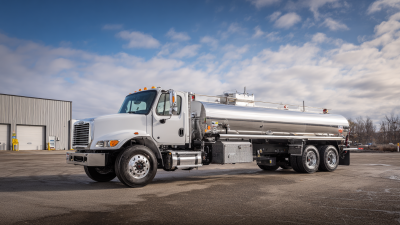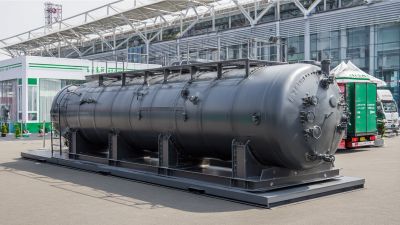Understanding the Benefits of a Diesel Transfer Tank with Pump for Efficient Fuel Management
In the realm of efficient fuel management, the "diesel transfer tank with pump" emerges as an indispensable tool for both personal and commercial applications. This innovative solution not only facilitates the effective transfer of diesel but also enhances the safety and convenience of fuel handling. As businesses and individuals seek ways to optimize their fuel expenses and reduce downtime, understanding the numerous benefits of utilizing a diesel transfer tank with pump becomes crucial. From ensuring compliance with safety regulations to maximizing operational efficiency, this equipment is designed to meet the diverse needs of users.

In this article, we’ll explore essential tips and insights that highlight how a diesel transfer tank with pump can significantly streamline fuel management processes, providing a practical and reliable option for those committed to maintaining a steady supply of diesel in their operations.
Choosing the Right Diesel Transfer Tank for Your Needs
When selecting the right diesel transfer tank for your needs, it's essential to consider several factors that can influence efficiency and effectiveness. First and foremost, the capacity of the tank should align with your fuel consumption needs. For users who frequently refuel heavy machinery or vehicles, a larger tank may be necessary to minimize downtime. Conversely, for smaller operations or infrequent refueling, a compact tank might be more suitable.
Another key consideration is the tank's material and construction. A robust, corrosion-resistant tank made from quality materials ensures longevity and reduces the risk of leaks or contamination. Additionally, evaluating the tank’s portability and compatibility with your existing equipment can streamline the refueling process. Features like built-in pumps, filters, and meters can enhance functionality, allowing for accurate monitoring and efficient fuel management. Ultimately, understanding your specific requirements and available features will guide you in choosing the optimal diesel transfer tank for your operation.
Key Features of a Diesel Transfer Tank with Pump
A diesel transfer tank with a pump is an essential tool for efficient fuel management, particularly in industries such as agriculture, construction, and transportation. One of the key features of these tanks is their ability to facilitate quick and safe refueling processes, which can significantly reduce downtime. According to a report by the National Institute for Occupational Safety and Health, improper handling of diesel fuel can lead to costly spills and safety hazards, making the use of a dedicated transfer tank a critical investment for businesses.
Moreover, diesel transfer tanks are designed with robust materials that resist corrosion and can withstand harsh environmental conditions. Many models are equipped with user-friendly pumps that offer flow rates of up to 15 gallons per minute, allowing for rapid fueling without compromising safety. A study conducted by the American Petroleum Institute found that facilities using transfer tanks saw a 25% increase in operational efficiency compared to those relying on traditional fuel sources. Additionally, features such as automatic shut-off valves and integrated filtration systems help prevent contamination and ensure that the diesel remains clean, further enhancing the reliability of the fuel management process.

How to Safely Operate a Diesel Transfer Tank
When operating a diesel transfer tank, safety should always be the foremost priority. Proper training and adherence to safety protocols can prevent accidents and ensure a smooth fuel transfer process. Always wear appropriate personal protective equipment (PPE), including gloves and safety glasses. It's crucial to check for any leaks, damage, or wear on the transfer tank and hoses prior to use, ensuring that no hazards are present.
**Tips:** Always ensure the area around the transfer tank is well-ventilated to minimize the buildup of fumes. Having a fire extinguisher nearby and knowing how to use it can be invaluable in case of an emergency. Make sure to secure the tank in place, preventing any movement during the filling or dispensing process.
In addition, regularly inspect your pump and equipment to guarantee they are functioning correctly. Pay attention to correct handling procedures, and avoid overfilling the tank. Maintain proper grounding and bonding to prevent static electricity buildup, which can lead to a spark and potential fire hazards. These practices will enhance your safety while maximizing efficiency during fuel management.
Benefits of Diesel Transfer Tanks with Pumps
This chart illustrates the key benefits of using diesel transfer tanks with pumps for fuel management. Each benefit is rated on a scale from 0 to 100, providing a clear visual representation of their importance in efficient fuel management.
Best Practices for Maintaining Your Diesel Transfer Tank
Maintaining a diesel transfer tank is crucial for ensuring efficient fuel management and prolonging the tank's lifespan. First, it's essential to regularly inspect the tank for any signs of wear or corrosion. A visual check can help identify leaks or structural issues that could lead to environmental hazards or fuel loss. Additionally, cleaning the tank periodically to remove any debris or sludge can prevent contamination and ensure that the fuel remains pure and functional.

Another best practice involves proper usage of the pump. Operators should be trained to handle the pump correctly, minimizing the risk of spills and accidents. Having a maintenance schedule for the pump itself can also enhance its reliability. This includes lubricating moving parts and checking for any mechanical issues. By following these maintenance steps, users can maximize the efficiency of their diesel transfer system and promote safer fuel handling practices in their operations.
Maximizing Efficiency in Fuel Management with Transfer Tanks
A diesel transfer tank with pump presents an effective solution for fuel management, particularly in industries that rely heavily on diesel-powered equipment. By utilizing a transfer tank, businesses can streamline fuel distribution, ensuring that machinery is always operational without unnecessary downtime. Efficient fuel management, as highlighted in recent studies, can lead to cost savings of up to 30% by minimizing wasted fuel and labor associated with refueling. Furthermore, transfer tanks aid in adhering to regulatory requirements regarding fuel storage and safety protocols.
Tips: When implementing a diesel transfer tank system, always ensure it complies with local environmental regulations and safety standards. Regular maintenance of the pump and tank is essential for optimal efficiency and preventing leaks that can lead to environmental hazards.
Investing in a diesel transfer tank not only enhances operational efficiency but also aligns with broader trends in energy management, inspired by technologies found in sectors like hydrogen energy systems and waste management. Research indicates that applying advanced fuel management strategies can significantly improve overall fuel economy, paralleling the adoption of innovative practices in other energy sectors. This is crucial as companies seek to optimize their resource use and transition towards more sustainable practices in response to evolving industry standards.
Understanding the Benefits of a Diesel Transfer Tank with Pump for Efficient Fuel Management
| Feature | Description | Benefits |
|---|---|---|
| Portability | Easy to transport and setup on different job sites. | Increased flexibility in fuel management operations. |
| Pump Efficiency | High-flow pumps designed for quick refueling. | Reduced downtime during fuel transfers. |
| Safety Features | Built-in safety features like automatic shut-off. | Minimized risk of spills and accidents. |
| Durability | Constructed from high-quality materials to withstand harsh environments. | Longer service life and lower replacement costs. |
| Versatile Applications | Suitable for various industries, from agriculture to construction. | Adaptability to different fueling needs enhances operational efficiency. |
Related Posts
-

Why Understanding Diesel Tanks is Essential for Your Business Operations
-

7 Reasons to Choose a Diesel Transfer Tank with Pump for Your Business
-

5 Best Diesel Fuel Tank Solutions for Your Business Efficiency
-

Exploring the Impact of Diesel Tank Innovations at the 138th Canton Fair 2025 in China
-

Understanding the Benefits of Using Above Ground Diesel Storage Tanks in Various Industries
-

How to Choose the Right Fuel Transfer Tank with Pump for Your Needs